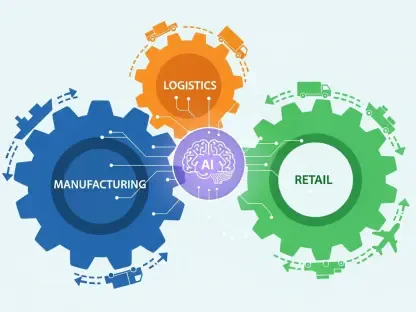In January 2025, the Chinese artificial intelligence (AI) company DeepSeek made headlines worldwide with the release of its mobile chatbot application and the DeepSeek-R1 large language model. The app quickly became the most downloaded on Apple Inc.’s U.S. App Store and secured a top position on the Google Play Store. This rapid rise had a significant impact on the technology sector, particularly in the United States, where it caused notable declines in tech stocks.
The Rise of DeepSeek
A New Player in the AI Market
DeepSeek’s swift ascent in the AI market was marked by the release of its mobile chatbot application and the DeepSeek-R1 model. Launched on January 10, 2025, the app quickly gained popularity, becoming the most downloaded app on Apple Inc.’s U.S. App Store by January 27. This success was mirrored on the Google Play Store, where it also secured a prominent position among the top downloads.
The impact of DeepSeek’s rise was felt across the technology sector, particularly in the United States. On January 27, U.S. tech stocks experienced significant declines, with NVIDIA Corporation seeing an unprecedented single-day plummet of 17% in share price, resulting in a loss of nearly $600 billion in market value. Analysts compared the release of DeepSeek to a “Sputnik moment,” challenging the longstanding belief in American technological supremacy.
Superior Efficiency and Affordability
The DeepSeek-R1 model distinguished itself by offering superior efficiency, affordability, and transparency compared to its American counterparts. It was estimated to be 95% cheaper than OpenAI’s ChatGPT-01 model and required only a tenth of the computational power needed by Meta Platforms’ Llama 3.1. This efficiency was achieved through significant algorithmic innovations that optimized computing power, contrasting with the massive data input and computational resource dependency observed in U.S. companies.
Adding to its innovative edge, DeepSeek adopted an open-source model and made its services freely available, accompanied by a comprehensive methodology report. This transparent approach deviated from the proprietary secrecy commonly embraced by American AI developers, fostering a collaborative environment within the global AI community.
DeepSeek’s AI Models
DeepSeek-V3: The Versatile Assistant
Released in December 2024, DeepSeek-V3 serves as an all-purpose chatbot assistant, competing with ChatGPT-40. It can interpret user prompts, respond in natural language, answer questions across academic and professional domains, and handle writing, editing, coding, and data analysis tasks. Despite its versatility, it encounters challenges with fact-checking, has a tendency to “hallucinate,” and often lacks deep insight, especially in abstract areas like beauty and humor. The bot’s ability to quickly process vast amounts of information made it a valued tool, even if certain areas needed refinement.
DeepSeek-V3 was designed to bridge several specialized functions into one comprehensive assistant. Its adaptability and broad application allowed users from various fields to leverage its features for their specific needs, enhancing productivity. Nevertheless, the model’s inclination to sometimes provide inaccurate information highlighted the need for continuous improvements and fact-checking mechanisms. Though these drawbacks did not undermine its utility substantially, they presented areas for further development to bolster its credibility and reliability.
DeepSeek-R1: The Reasoning Model
Launched in January 2025, DeepSeek-R1 is designed for step-by-step logical deduction and complex problem-solving, directly competing with the ChatGPT-01. This model excels in high-level reasoning tasks and showcases DeepSeek’s focus on computational efficiency. Its release marked a significant milestone in the company’s journey, highlighting its commitment to innovation and efficiency. DeepSeek-R1 was celebrated for its ability to perform intricate tasks with fewer resources, presenting an economical advantage not seen in other models of its kind.
This model’s capabilities extend to various domains requiring detailed logical analysis and sequential problem-solving. As companies and professionals began utilizing DeepSeek-R1, its benefits in those settings became evident, resulting in widespread recognition. Despite being relatively new in January 2025, the model’s user-friendly interface, combined with impressive reasoning abilities, immediately set it apart from its competitors, reinforcing DeepSeek’s innovative prowess.
Janus Pro: Image Generation and Visual Analysis
Specializing in image generation and visual analysis, Janus Pro is comparable to OpenAI’s DALL-E 3, Midjourney, and Stability AI’s Stable Diffusion. Available in 1B and 7B parameter versions, it generates high-quality images and engages in detailed discussions about real-world photographs. While significant, this model has not had as disruptive an impact as DeepSeek’s chatbot models. Janus Pro carved out its niche by providing creative and analytical visual outputs, making it valuable yet less revolutionary compared to the groundbreaking advances in language models.
Janus Pro’s capabilities in producing artistic and photographic content augmented various industries, including advertising, filmmaking, and design. However, its level of disruption was moderated by the fact that it primarily enhanced existing workflows rather than fundamentally transforming them. As other sectors watched DeepSeek’s language models reshape their operations, Janus Pro quietly proliferated its influence, reinforcing the versatility and breadth of DeepSeek’s AI innovations.
The Visionary Behind DeepSeek
Liang Wenfeng: From Mathematics Prodigy to AI Pioneer
DeepSeek’s journey to prominence began with its founder Liang Wenfeng, a mathematics prodigy from Guangdong province. Liang graduated from Zhejiang University and initially applied AI to the financial markets through High-Flyer, a hedge fund he cofounded in 2016. By 2017, AI systems managed most of High-Flyer’s trading activities, establishing the firm as a leader in AI-driven stock trading. This early venture into AI applications set the stage for Liang’s future endeavors, demonstrating his ability to leverage cutting-edge technology for substantial financial gains.
Recognizing AI’s potential, Liang began stockpiling NVIDIA GPUs in 2021, prior to U.S. government restrictions on chip sales to China. Accumulating around 10,000 NVIDIA A100 GPUs, Liang laid a solid foundation for future AI advancements. In April 2023, High-Flyer announced an artificial general intelligence lab, which evolved into DeepSeek by July 2023, with High-Flyer as its primary backer.
Breakthroughs and Market Impact
DeepSeek’s first major breakthrough was the May 2024 release of the chatbot model DeepSeek-V2, which gained widespread popularity in China due to its cost-efficiency and performance superiority over offerings from companies like ByteDance, Tencent, Baidu, and Alibaba. This success sparked a price war, compelling competitors to significantly reduce their AI model prices. Building on this momentum, DeepSeek released DeepSeek-V3 in December 2024, followed by DeepSeek-R1 and the chatbot application in January 2025, marking its entry into the international market and challenging the assumption of U.S. AI dominance.
DeepSeek’s ascent drew the attention and support of the Chinese government, including a symposium with Premier Li Qiang. Distinguishing itself from other Chinese tech firms known for their demanding “996” work culture, DeepSeek fostered a meritocratic environment, prioritizing technical competence over extensive work experience and recruiting recent graduates from diverse academic backgrounds. This approach encouraged creativity, passion, and collaboration, drawing inspiration from Western work cultures.
Regulatory and Security Concerns
DeepSeek Under Scrutiny
DeepSeek’s rapid rise also attracted scrutiny and backlash. By early February 2025, several governments and organizations had imposed restrictions on the company, citing national security and data privacy concerns. Taiwan was the first to act, banning DeepSeek from government agencies on January 27. The next day, Texas Governor Greg Abbott prohibited its use on government-issued devices. Subsequent bans were implemented by NASA, the U.S. Navy, Italy’s data protection authority, and the Australian government, all of which emphasized security risks associated with foreign AI platforms.
Cybersecurity Challenges
In addition to regulatory challenges, DeepSeek faced a large-scale cyberattack on January 29, prompting the suspension of new user registrations outside mainland China. The attack exposed multiple vulnerabilities, including a widely shared “jailbreak” exploit and a data breach involving over one million sensitive records. This incident highlighted the security challenges in AI development and the competitive and adversarial nature of global AI advancements. While DeepSeek quickly moved to address these issues, the event underscored the importance of robust cybersecurity measures in protecting sensitive data and maintaining user trust.
Censorship and Content Moderation
Censorship within DeepSeek’s AI models further reflected the company’s alignment with Chinese government policies. The models avoided politically sensitive topics, providing vague responses or reiterating official positions on issues like Xi Jinping, the 1989 Tiananmen Square incident, Tibet, Taiwan, and the persecution of Uyghurs. This strict censorship was embedded at both the training and application levels, making it difficult to remove even in open-source versions. In contrast, American AI models also enforced content moderation but faced accusations of political bias shaped by corporate policies, legal risks, and social norms, rather than government mandates.
Conclusion: Future Implications of DeepSeek’s Rise
In January 2025, the Chinese AI company DeepSeek made a significant splash internationally by launching its mobile chatbot application alongside the DeepSeek-R1 large language model. Upon its release, the app quickly rose to prominence, becoming the most downloaded application on Apple’s App Store in the U.S. Similarly, it secured a top-ranking position on the Google Play Store. This swift ascent drew considerable attention, leading to substantial ripples in the technology sector. The sudden popularity and wide adoption of DeepSeek’s app had a marked impact, particularly noted in the U.S. where tech stocks experienced noteworthy declines.
The influence of DeepSeek’s innovations signaled a pivotal moment in the AI landscape. Their advanced technology captivated users, reshaping expectations and standards for AI applications globally. Industry analysts noted that the unprecedented success of the DeepSeek-R1 model underscored the growing competitiveness and technological prowess of Chinese tech firms in the global market. This event highlighted the dynamic nature of the tech sector, reminding businesses and investors alike of the unpredictable shifts that can result from groundbreaking advancements. It also raised conversations about the future interplay between international tech companies and the potential shifts in market dynamics influenced by rapid technological progress.









